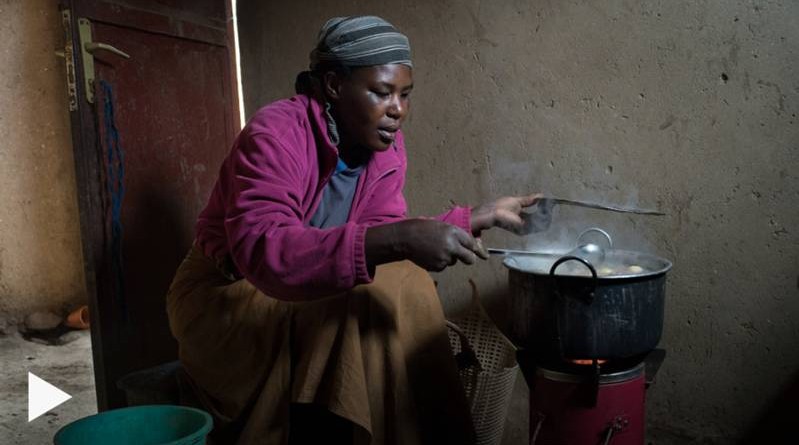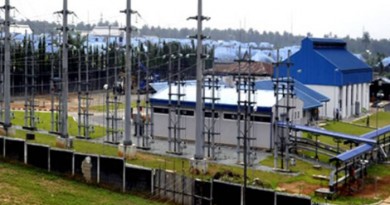Toxic Smoke Is Africa’s Quiet Killer. An Entrepreneur Says His Fix Can Make a Fortune
Eric Reynolds will tell you that he is on the verge of freeing much of humanity from the deadly scourge of the cooking fire.
He is happy to explain, at considerable length, how he will systematically achieve all this while constructing a business that can amass billions in profit from an unlikely group of customers: the poorest people on earth.
He will confess that some people doubt his hold on reality.
“A lot of people think it’s too good to be true,” says Mr. Reynolds, a California-born entrepreneur living in Rwanda. “Most people think I am pretty out there.”
The company he is building across Rwanda, Inyenyeri, aims to replace Africa’s overwhelming dependence on charcoal and firewood with clean-burning stoves powered by wood pellets. The business has just a tad more than 5,000 customers and needs perhaps 100,000 to break even. Even its chief operating officer, Claude Mansell, a veteran of the global consulting company Capgemini, wonders how the story will end.

“Do we know that it’s going to work?” he asks. “I don’t know. It’s never been done before.”
Inyenyeri presents a real-world test of an idea gaining traction among those focused on economic development — that profit-making businesses may be best positioned to deliver critically needed services to the world’s poorest communities.
Governments in impoverished countries lack the finance to attack threats to public health, and many are riddled with corruption (though, by reputation, not Rwanda’s). Philanthropists and international aid organizations play key roles in areas such as immunizing children. But turning plans for basic services into mass-market realities may require the potent incentives of capitalism. It is a notion that has provoked the creation of many businesses, most of them failures.
“Profit feeds impact at scale,” says Mr. Reynolds, now in the midst of a global tour as he courts investment on top of the roughly $12 million he has already raised. “Unless somebody gets rich, it can’t grow.”
More than four decades have passed since Mr. Reynolds embarked on what he portrays as an accidental life as an entrepreneur, an outgrowth of his fascination with mountaineering. He dropped out of college to start Marmot, the outdoor gear company named for the burrowing rodent. There, he profited by protecting Volvo-driving, chardonnay-sipping weekend warriors against the menacing elements of Aspen. Now, he is trying to build a business centered on customers for whom turning on a light switch is a radical act of upward mobility.
Inyenyeri is betting that it can give away stoves and make money by charging people for fuel. If it succeeds, it vows to deliver virtues that go well beyond the bottom line.
The forests would be spared, because making wood pellets requires far fewer trees than wood fires and charcoal. Customers would gain a reprieve from ailments related to smoke from cooking, including cataracts, heart disease and respiratory ailments that, in many countries, kill more people than malaria, H.I.V. and tuberculosis combined. Worldwide, close to 4 million people die prematurely each year from ailments linked to air pollution from cooking, according to the World Health Organization.
Rwandans in rural areas — and, eventually, across Africa and South Asia — would be freed from the time-sucking drudgery of having to look for wood. People in cities, who rely on charcoal, could switch to cheaper wood pellets, using the savings to buy health care, food and school uniforms.
In much of the developing world, initiatives aimed at sparing the environment tend to pit the livelihoods of poor people against the protection of natural resources. Peasants in the Amazon are supposed to stop hacking away at forests to clear land for crops so the rest of the planet can benefit from a reduction in carbon emissions. Yet in Inyenyeri’s designs, the everyday concerns of poor households are aligned with environmental imperatives, because people prefer to cook with the stoves.
At 66, with sunburned cheeks and intense blue eyes, Mr. Reynolds can at times sound like the latest white man come to save Africa. “It’s just outrageous that we have three billion people still cooking in the Stone Age,” he says. “It’s entirely solvable.”
He touts his ability to connect with customers, the women who do the cooking in Rwanda, though even after a decade living in the country he does not speak the local language, Kinyarwanda. He sits on the dirt floors of villagers’ homes and speaks English slowly and loudly, exaggerating each syllable. Rwandan women trust him, he says, because he married one. He hands them his phone and displays the proof — pictures of his wife, Mariam Uwizeyimana Reynolds, 32, and their two fresh-faced boys, Terry Toulumne Reynolds, 6, and Marc Booth Reynolds, 3.
On a recent evening, he visits Buzuta village, a scattering of mudwall huts on a rutted dirt road in western Rwanda, not far from the shore of Lake Kivu. He sits opposite Mukamurenzi Anasthasie, who is rearing two grandchildren and two orphans in a house with neither plumbing nor electricity.
For most of her 60 years, Ms. Anasthasie watched the daylight seep away with a sense of dread, anxious that darkness might fall before she could find enough wood to cook a meal. The forests that once surrounded her village had been dismantled and hacked into firewood. She and her neighbors wandered for hours into the surrounding mountains looking for sticks.
“Sometimes, we’d just collect dry grasses and try to cook with those,” she says. “Sometimes — especially if it rained — we just didn’t eat. It was painful. We were constantly worrying about where we could find wood.”
Two years ago, Ms. Anasthasie traded her cooking fire for an Inyenyeri stove, a red cylinder holding a chamber to burn pellets that sits on her dirt floor. She no longer spends her day worrying about wood. She and the children have been relieved of their constant coughing. She can put beans on to simmer and walk away and do something else.
“I don’t have to waste time waiting for food,” she says.
Defusing the Time Bomb
In Mr. Reynolds’s telling, his career in business was born of a simple desire to sleep comfortably.

It was the early 1970s, and he was 21 years old, officially studying climatology at the University of California, Santa Cruz, yet spending most of his time scaling the granite walls of the Yosemite Valley. He and his climbing partner were unhappy with their bulky sleeping bags. They began sewing their own. As word spread that their bags were lightweight and warm, demand soared. Mr. Reynolds left school to pursue Marmot full time.
Revenues multiplied, but Mr. Reynolds was restless. As a kid in Davis, where his father taught microbiology at the University of California campus, he had been reared on the works of the Rev. Dr. Martin Luther King Jr. and Gandhi. He carried a sense that he was supposed to be addressing injustice.
“At the end of the day,” he says, “all we really did was keep yuppies warm and dry.”
He left Marmot in 1987, passing the years scaling peaks from the Andes to the Himalayas while based in Boulder, Colo. He took over a start-up that sold water-purifying pumps for backpackers. He worked as a consultant.
Then, in the summer of 2003, he conceived what was supposed to be his ultimate creation, a business engineered to achieve social-minded goals. The company, Nau, designed and sold outdoor gear made from environmentally sustainable fabric. It sent 5 percent of its revenue to activist organizations. It raised $35 million in less than two years.
Barely a year in, Mr. Reynolds was pushed out in a power struggle. He descended into depression.
An old friend was helping design a memorial to victims of the 1994 genocide in Rwanda. She invited Mr. Reynolds to help.

He flew into the capital, Kigali, in March 2007, and drove seven hours over horrendous dirt roads to the village that held the memorial. The country he traversed was raw and broken. Thirteen years had passed since the wave of murder that had killed perhaps 800,000 people in 100 days, yet Rwanda was still seething with grief and distrust.
The infant mortality rate was one of the highest on earth. Life expectancy was less than 60 years. The typical Rwandan had an income of $206 per year.
As Mr. Reynolds visited villagers, he was struck by the impossibility of their daily existence. Clean drinking water was nonexistent. So were electricity and toilets. People spent hours fetching water and looking for wood.
“Every time I went inside, I became more and more intrigued,” he says. “How are these people surviving?”
Signs of the charcoal industry were inescapable. Fires wafted up from supposedly protected national forests. Steep, verdant hills once covered in rain forest were denuded and exposed to the elements. Rivers were choked with brown silt, the soil and nutrients stripped off the land by pounding rains.
All this, to produce fuel that was quietly killing hundreds of thousands of people across Africa.
“There is nothing in the house that causes as much suffering as cooking,” Mr. Reynolds says. “It’s dirty. It’s smoky. Momma is there with the baby on her back, and both are coughing. It’s ruinously expensive. I could see the trees disappearing and the mudslides forming. I could see that this was a time bomb.”
After three weeks in Rwanda, he returned to Boulder and tore into books and academic reports on cooking practices and stove technology.
Philanthropic efforts were focused on distributing cleaner-burning stoves. For-profit ventures were developing models for sale. But all of these undertakings were bedeviled by the same problem. The high-tech stoves that limited toxic smoke were as much as $150 each — preposterously expensive for African villagers, many of whom lived on less than 50 cents a day. The cheaper models were useless.
Most manufacturers were obsessed with keeping costs low, given that customers were poor. But the stoves still produced smoke, or took too long to cook, or required that the wood be chopped into little pieces — an extra burden. The women doing the cooking (and it was overwhelmingly women) were not inclined to use them. As Mr. Reynolds returned to Rwanda for research, he saw many of these models stuck behind houses or propped up by the cooking fire as stools.
To succeed, a stove had to be so convenient and clean burning that women preferred it over their existing cooking method.

Mr. Reynolds began testing stoves made in Italy, India, the United States and China. He tried making his own.
He came to realize that the magic was in the combination of stove and fuel. He experimented with making charcoal out of corncobs. (“A stupid idea,” he says.) He tried burning banana leaves. Then he discovered wood pellets, which involve compressing wood and eliminating water, the element that produces much of the smoke.
He settled on a Dutch-made stove that reduces wood down to clean-burning gases. Using pellets reduced the need for wood by 90 percent compared with charcoal. But those stoves cost more than $75.
Then came the epiphany: Inyenyeri could supply the stoves for free while collecting revenue from subscriptions for pellets. Rwanda was urbanizing rapidly, and city dwellers rely on charcoal. They would be eager to switch to pellets, which were 30 to 50 percent cheaper.
“If you sell fuel every day rather than selling a stove every two years,” Mr. Reynolds says, “that’s a business.”
Customers in rural areas could not afford to buy pellets, but Inyenyeri could serve them with a barter system. People could gather sticks, though less than they needed for cooking, and exchange them for pellets. Inyenyeri would use the sticks to make more pellets.
In this way, Inyenyeri would effectively become a utility providing clean cooking fuel. It would construct a network of factories to produce pellets. The bigger the business grew, the cheaper the cost of making them. As charcoal rose in price — a trend propelled by growing numbers of people flocking to cities and needing the product — the more appealing pellets would look.
That development was getting a push from African governments intent on reducing the use of charcoal. Across the continent, charcoal is a $40 billion-a-year industry, one dominated by criminal gangs that pilfer public forests and employ child labor. Rwanda’s government has vowed to phase out its use.
“To be able to sell something that is essential to life, and where the government is actively trying to kill your competition,” Mr. Reynolds says, “is the kind of investment that venture capitalists hunger for.”
Inyenyeri would start in Rwanda, where the government has gained credibility with international aid organizations for its success in reducing poverty. It could use success there as a springboard for expansion across Africa.
The business model would get more attractive as the cost of charcoal climbed, and as innovation inevitably made stoves more efficient. Inyenyeri would also stand to collect revenue from an arrangement it later entered into with the World Bank to sell credits for reducing emissions.
In 2010, Mr. Reynolds sold his house in Boulder and went all in on Inyenyeri. He unloaded his wine cellar, liquidated his retirement accounts and moved to Rwanda with no plan to leave.
Life Transformed
Today, Inyenyeri has distribution offices in cities and villages in Rwanda, including one inside a camp for refugees from the neighboring Democratic Republic of Congo. It runs a small-scale pellet plant in Gisenyi, a city on Lake Kivu, and is developing a bigger factory.
Company representatives go home with new customers to help them cook their first meal using their new stoves. Inyenyeri delivers pellets for free using bicycle messengers, and is close to rolling out a system that will allow customers to place orders using a smartphone.
The company has engineered its own customer management software to track purchases of pellets, customer cooking habits and a host of other data, updated in real time by people in the field using a mobile app. The data has attracted research institutions including the National Institutes of Health, Johns Hopkins University and the University of North Carolina. They have undertaken studies probing how clean cooking technology affects public health, and how families freed from gathering wood use their extra time.

But one crucial element is still missing — scale.
In every company projection, a steep increase in customer numbers is required for the business to become profitable. Inyenyeri now needs to persuade investors to deliver the cash to buy hundreds of thousands of stoves and erect new pellet plants.
For Mr. Reynolds, the all-or-nothing uncertainties are familiar. Back in his climbing days, he habitually opted for less-traveled routes. On an ascent of Everest that featured a rarely employed bypass around a treacherous ice field, he spent 58 days camped in the thin air between 20,000 and 28,000 feet above sea level.
Advertisement
But Mr. Reynolds nurses fears. Once Inyenyeri demonstrates the potential in the clean cooking fuel industry, he says, greedy competitors are likely to emerge. They could pick off the wealthiest urban customers while abandoning the rural poor. They could buy wood from unsavory sources.
“I worry we could create a monster,” he says. “You’re going to see us make a lot of money, and others are going to flock to this to make even more money by not being scrupulous.”
But if the virtues of the business model have yet to be demonstrated, the demand for Inyenyeri’s product appears overwhelming. Everywhere the company expands, word-of-mouth swiftly exhausts the supply of stoves. Customers speak of emancipation from smoke, and of less need to haul jerrycans of water to their homes from taps 20 or 30 minutes away by foot, because their pots are no longer covered in soot and need less washing.

In Buzuta village, Dorcas Nyiransabimana, a mother of two, simmers beans and leaves them untended while she prepares to feed the pigs she keeps in a pen next to her house.
Twice a year, she sells piglets, fetching 15,000 Rwandan francs (about $17), an enormous sum in rural Rwanda. With her cooking fuel secured, she can spend more time scavenging for food for the pigs — milk past its sell date from a nearby dairy and discarded grains from a brewery.
Nearby, the walls of Ms. Anasthasie’s house are bare, save for a torn poster of pop stars — Rihanna, Beyoncé, Tupac. A low wooden table and three stools are the only furniture in her home. The red Inyenyeri stove glows like a totem of modernity.
She used to be trapped by her wood fire. Now, she leaves her pot to cook and gathers banana leaves to feed to the goat she keeps tethered to a tree.
“Before, I’d find leaves for the goat and come back and not have time to cook for me and the family,” she says. “Or I’d cook for us and the goat would not get to eat. Now, we all get to eat — us, and the goat.”
Mr. Reynolds hears this story as darkness falls. As he walks up the dirt road through the village toward his car, cook fires are glowing inside houses, smoke wafting skyward.
“This business model will happen,” he says. “If it’s not Inyenyeri that’s the first mover, then it will be someone else who learns from our mistakes and does it better. It’s too big of an opportunity.”
FROM THE NEW YORK TIMES




